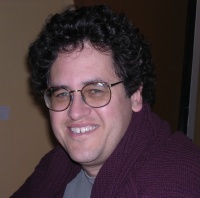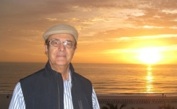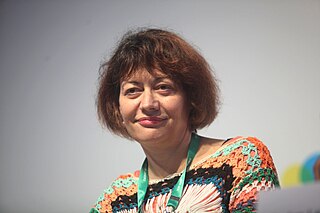Related Research Articles

Siegfried Fred Singer was an Austrian-born American physicist and emeritus professor of environmental science at the University of Virginia, trained as an atmospheric physicist. He was known for rejecting the scientific consensus on several issues, including climate change, the connection between UV-B exposure and melanoma rates, stratospheric ozone loss being caused by chlorofluoro compounds, often used as refrigerants, and the health risks of passive smoking.

Leonhard Euler was a Swiss mathematician, physicist, astronomer, geographer, logician and engineer who founded the studies of graph theory and topology and made pioneering and influential discoveries in many other branches of mathematics such as analytic number theory, complex analysis, and infinitesimal calculus. He introduced much of modern mathematical terminology and notation, including the notion of a mathematical function. He is also known for his work in mechanics, fluid dynamics, optics, astronomy and music theory.

Martin Gardner was an American popular mathematics and popular science writer with interests also encompassing scientific skepticism, micromagic, philosophy, religion, and literature – especially the writings of Lewis Carroll, L. Frank Baum, and G. K. Chesterton. He was also a leading authority on Lewis Carroll. The Annotated Alice, which incorporated the text of Carroll's two Alice books, was his most successful work and sold over a million copies. He had a lifelong interest in magic and illusion and in 1999, MAGIC magazine named him as one of the "100 Most Influential Magicians of the Twentieth Century". He was a prolific and versatile author, publishing more than 100 books.

Numerology is the belief in an occult, divine or mystical relationship between a number and one or more coinciding events. It is also the study of the numerical value, via an alphanumeric system, of the letters in words and names. When numerology is applied to a person's name, it is a form of onomancy. It is often associated with the paranormal, alongside astrology, and is similar to divinatory arts.

A prime number is a natural number greater than 1 that is not a product of two smaller natural numbers. A natural number greater than 1 that is not prime is called a composite number. For example, 5 is prime because the only ways of writing it as a product, 1 × 5 or 5 × 1, involve 5 itself. However, 4 is composite because it is a product (2 × 2) in which both numbers are smaller than 4. Primes are central in number theory because of the fundamental theorem of arithmetic: every natural number greater than 1 is either a prime itself or can be factorized as a product of primes that is unique up to their order.

In probability theory and related fields, a stochastic or random process is a mathematical object usually defined as a sequence of random variables, where the index of the sequence has the interpretation of time. Stochastic processes are widely used as mathematical models of systems and phenomena that appear to vary in a random manner. Examples include the growth of a bacterial population, an electrical current fluctuating due to thermal noise, or the movement of a gas molecule. Stochastic processes have applications in many disciplines such as biology, chemistry, ecology, neuroscience, physics, image processing, signal processing, control theory, information theory, computer science, and telecommunications. Furthermore, seemingly random changes in financial markets have motivated the extensive use of stochastic processes in finance.

The Large Scale Structure of Space–Time is a 1973 treatise on the theoretical physics of spacetime by the physicist Stephen Hawking and the mathematician George Ellis. It is intended for specialists in general relativity rather than newcomers.

John Carlos Baez is an American mathematical physicist and a professor of mathematics at the University of California, Riverside (UCR) in Riverside, California. He has worked on spin foams in loop quantum gravity, applications of higher categories to physics, and applied category theory. Additionally, Baez is known on the World Wide Web as the author of the crackpot index.

Mathematical physics refers to the development of mathematical methods for application to problems in physics. The Journal of Mathematical Physics defines the field as "the application of mathematics to problems in physics and the development of mathematical methods suitable for such applications and for the formulation of physical theories". An alternative definition would also include those mathematics that are inspired by physics.

Isadore Manuel Singer was an American mathematician. He was an Emeritus Institute Professor in the Department of Mathematics at the Massachusetts Institute of Technology and a Professor Emeritus of Mathematics at the University of California, Berkeley.
Frank Jennings Tipler is an American mathematical physicist and cosmologist, holding a joint appointment in the Departments of Mathematics and Physics at Tulane University. Tipler has written books and papers on the Omega Point based on Pierre Teilhard de Chardin's religious ideas, which he claims is a mechanism for the resurrection of the dead. He is also known for his theories on the Tipler cylinder time machine. His work has attracted criticism, most notably from Quaker and systems theorist George Ellis who has argued that his theories are largely pseudoscience.
The Bogdanov affair was an academic dispute regarding the legitimacy of a series of theoretical physics papers written by French twins Igor and Grichka Bogdanov. The papers were published in reputable scientific journals, and were alleged by their authors to culminate in a theory for describing what occurred before and at the Big Bang.

The sociology of scientific knowledge (SSK) is the study of science as a social activity, especially dealing with "the social conditions and effects of science, and with the social structures and processes of scientific activity." The sociology of scientific ignorance (SSI) is complementary to the sociology of scientific knowledge. For comparison, the sociology of knowledge studies the impact of human knowledge and the prevailing ideas on societies and relations between knowledge and the social context within which it arises.

Irving Ezra Segal (1918–1998) was an American mathematician known for work on theoretical quantum mechanics. He shares credit for what is often referred to as the Segal–Shale–Weil representation. Early in his career Segal became known for his developments in quantum field theory and in functional and harmonic analysis, in particular his innovation of the algebraic axioms known as C*-algebra.

Ruggero Maria Santilli is an Italo-American nuclear physicist. Mainstream scientists dismiss his theories as fringe science.
A Usenet personality was a particular kind of Internet celebrity, being an individual who gained a certain level of notoriety from posting on Usenet, a global network of computer users with a vast array of topics for discussion. The platform is usually anonymous, although users can get celebrity status, usually by being deemed different from other posters in some way.

Science and technology in Russia have developed rapidly since the Age of Enlightenment, when Peter the Great founded the Russian Academy of Sciences and Saint Petersburg State University and polymath Mikhail Lomonosov founded the Moscow State University, establishing a strong native tradition in learning and innovation.

Applied mathematics is the application of mathematical methods by different fields such as physics, engineering, medicine, biology, finance, business, computer science, and industry. Thus, applied mathematics is a combination of mathematical science and specialized knowledge. The term "applied mathematics" also describes the professional specialty in which mathematicians work on practical problems by formulating and studying mathematical models.

Claudia Alejandra Sagastizábal is an applied mathematician known for her research in convex optimization and energy management, and for her co-authorship of the book Numerical Optimization: Theoretical and Practical Aspects. She is a researcher at the University of Campinas in Brazil. Since 2015 she has been editor-in-chief of the journal Set-Valued and Variational Analysis.

The Faculty of Science of Eötvös Loránd University was founded in 1949 and it is located in Lágymányos Campus, Újbuda, Budapest, Hungary.
References
- ↑ Hubbard, Douglas W. (2009-04-27). The Failure of Risk Management: Why It's Broken and How to Fix It. John Wiley & Sons. ISBN 9780470387955.
- ↑ Wired Staff. "Every field of study deserves its own Crackpot Index". WIRED. Archived from the original on July 17, 2018. Retrieved 2018-07-17.
- ↑ "Towards a universal crackpot standard". New Scientist . 28 April 2010. Retrieved 2023-08-10.
- ↑ "Crackpot index". math.ucr.edu. Retrieved 2018-07-17.
- ↑ "Crackpot index". 1996-11-10. Archived from the original on 1996-11-10. Retrieved 2018-07-17.
- ↑ "Feedback". New Scientist . 5 December 1992. Retrieved 2023-08-10.
- ↑ Kesterton, Michael (11 Dec 1992). "Social Studies a Daily Miscellany of Information by Micheal Kesterton About the Body …". The Globe and Mail . Toronto. p. A.28.
- ↑ Baez, John (23 January 1993). "Letters: Crackpot credit". New Scientist . No. 1857. Retrieved 2023-08-10.
- ↑ Baez, John (2001). "The crackpot index". Skeptic . Vol. 8, no. 4. Altadena, CA. Contents
- ↑ Chris Caldwell. "The PrimeNumbers' Crackpot index" . Retrieved October 23, 2007.
- ↑ Fred J. Gruenberger. "A Measure for Crackpots" (PDF).